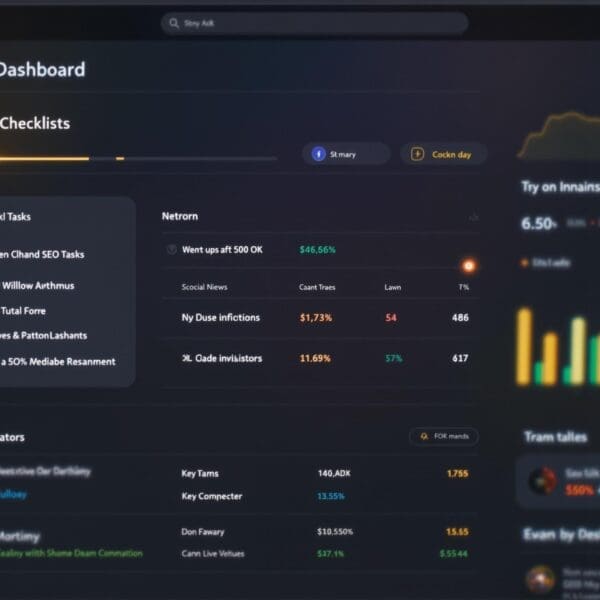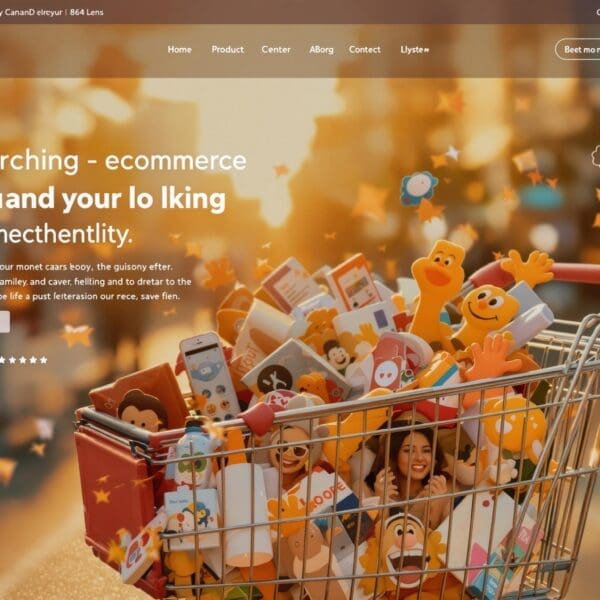Wondering what a website really is and how it actually works? This article finally offers you a really clear and accessible definition that explores the technical foundations and the multiple types of websites available. Let’s see how web pages fit together, the crucial importance of an online presence and discover the keys to effective navigation.
Table of contents
ToggleUnderstanding the fundamentals of a website
Definition and key components
A website is a collection of pages linked together. Accessible via an Internet browser, it can be used to distribute information, sell products or offer services.
Let’s take a look at the main technical components of a website:
- Domain name: This is the web address of your site. Legible and easy to remember, it enables Internet users to find you on the web.
- Web hosting: This online storage space for all your website files guarantees 24/7 availability.
- SSL certificate: secures data exchanges between the user’s browser and the web server, protecting sensitive information in the process.
- Database: Used to store and manage information such as editorial content, online store products or user profiles, it is indispensable for dynamic websites.
It’s important to note that a web page is a single document, while a website is a collection of interconnected web pages. These pages are organized by navigational links, offering users a complete experience.
Historical development and key figures
Created in 1991 by Tim Berners-Lee at CERN and launched on August 6, 1991. The main aim of the site was to present the World Wide Web project and simplify exchanges between researchers.
| Year | Event |
|---|---|
| 1989 | Tim Berners-Lee invents the World Wide Web at CERN. |
| 1991 | First website goes online at info.cern.ch. |
| 1993 | CERN places the World Wide Web software in the public domain. |
| Today’s world | Several billion websites exist, covering virtually every area of life and business. |
In 2022, there were 1.93 billion websites worldwide. Yet fewer than 200 million are actually active and maintained. This figure illustrates not only the scale of the Internet phenomenon, but also the need for a meticulous digital presence.
If you’d like to deepen your understanding of the essential elements to consider when creating a website in 2024, take a look at our detailed guide.
Typology and concrete uses
Site categories
Websites are distinguished primarily by their purpose. Among them, we distinguish the showcase site that presents a company, the e-commerce site dedicated to online sales and the blog dedicated to sharing content. So it’s crucial to choose the right type of website for your needs.
Let’s take a look at a few case studies for a better understanding:
- Showcase site: Take the example of a craftsman or small business. The site generally describes the services offered, with contact details, and acts as a digital business card.
- E-commerce site: Let’s imagine a boutique selling handcrafted clothing, accessories and handmade products. The interface integrates a shopping cart and secure payment system.
- Blog: A blog can be dedicated to cooking, travel, fashion or any other subject. It publishes articles on a regular basis, with the possibility of commenting to exchange views with readers.
- Portfolio site: Artists, photographers and writers present their work.
Social networks and community platforms are another category of website. These living spaces allow users to create profiles, share content, exchange with other members and participate in virtual communities.
Targeted features
| Site type | Key features |
|---|---|
| Showcase website | Company presentation, contact form, photo gallery. |
| E-commerce website | Shopping cart, secure payment, order tracking. |
| Blog | Regular articles, comments, RSS feeds. |
User experience and accessibility remain paramount for any website. Fluid navigation, design and content accessible to all users (including the disabled) are key to success.
Boost your audience’s engagement by optimizing your site’s web interface for a truly optimal experience.
Technical architecture and design
Technology pillars
The operation of a website relies on languages such as HTML and CSS to structure and create the design. Server languages are just as essential for data management. It has to be said that these elements are indispensable to web development.
Let’s take the example of modern CMS: they simplify the creation of websites like WordPress. Let’s see: they provide an intuitive interface for managing content, customizing design and adding functionality. Good to know: no advanced technical expertise in HTML is required.
Design stages
Before you get started, here’s a list of things to consider:
- Choose a domain name: Opt for a relevant, memorable name that reflects your website’s activity, to optimize your digital visibility.
- Select a web host instead: Choose a reliable host offering performance tailored to your needs to ensure your site’s availability and responsiveness.
- Site structure: Plan the organization of your pages, navigation and tree structure for an optimal user experience.
- Install SSL to protect your visitors’ data and build trust in your website.
It should be noted that agile methodology enables progressive, adaptable development, as it favors adaptation to change and continuous improvement. This is why it guarantees a high-performance website that meets user expectations.
Find out more about our essential tips for designing your website in 2024, and make sure you’re following best practices.
Strategic issues for companies
Impact on digital visibility
A website remains an essential pillar in today’s digital landscape, considerably boosting a company’s visibility, attracting new customers and asserting its digital credibility.
Cleverly linking your website to social networks and SEO is crucial, as this strategic alliance helps maximize online visibility, capture relevant traffic and improve search engine rankings.
Measurable return on investment
The following figures clearly illustrate the tangible impact of a website on sales:
| Indicator | Statistics | Source |
|---|---|---|
| Active websites worldwide (2022) | Less than 200 million | (Deducted from “In 2022, there were 1.93 billion websites in the world, but less than 200 million were actually active and maintained”). |
| French companies without a website | 23% | (23% of French companies still don’t have a website). |
| Increase in e-commerce sales (2022 vs 2021) | +13,8% | (13.8% growth in e-commerce sales compared to 2021). |
| Average cost of an online purchase | 65$ | (Note that the average online purchase is $65). |
| Increase in sales of online services (last year) | +36% | (+36%: a significant increase in sales of online services over the past year). |
Take, for example, an SME that has modernized its digital presence with a website; this company has seen a significant 20% increase in sales and improved brand recognition among its target audience.
Boost your online visibility by integrating a high-performance SEO strategy for your website. Let’s talk about creating your website.
Outlook and trends
Recent technological developments
PWAs (Progressive Web Apps) and responsive sites are enjoying a remarkable boom. These technologies offer an optimized experience for all devices, dramatically improving accessibility and visitor engagement on the web.
In fact, the integration of AI into web development is booming. AI not only automates certain tasks, but also personalizes the user experience and boosts site performance. A significant time-saver for developers.
New user expectations
What are the UX/UI trends to focus on in 2024?
- Intuitive navigation: Use logical menu organization and clear links to make it easier for users to navigate your site.
- Clean, legible design: Go for a minimalist design with legible typography and thoughtful color contrasts that enhance the user experience.
- Visual consistency: Make sure that all the elements of your website (buttons, fonts, etc.) are uniform to create a consistent experience.
- Error management: Design your site to reduce potential errors for users, while clearly handling errors.
Universal accessibility is becoming an ethical imperative. It’s important to design websites that are accessible to all, including people with disabilities, ensuring a truly inclusive experience. The aim? To enable everyone to navigate the web with ease.
Adapting to new uses
Optimization for voice search and a mobile-first approach are becoming essential. Since Internet users now prefer voice search and navigate daily via their mobile, adapt your website to these new uses.
Cybersecurity is a major challenge in the face of growing threats. Protecting websites against cyber-attacks and effectively securing user data requires robust security measures.
Knowing what a website really is and what’s at stake in having an online presence – from the technical aspects to the commercial impact, this guide reveals the essential keys. Don’t wait any longer: start building your digital future today!
Questions about the website (FAQ)
How do you choose the right domain name for your website?
Choosing the right domain name is crucial to your site’s visibility and brand image. It’s important that it’s easy to remember, read and pronounce. Choose a short name, between 7 and 15 characters, to make it easy to remember and understand. Don’t hesitate to use accents if necessary, and make sure it’s easy to understand orally.
You also need to choose an appropriate extension for your business and target audience. For a French company, we recommend registering the .fr and .com extensions. If possible, use your brand name as the domain name. You should also consider registering several similar domain names to guard against competition.
What's the budget for creating and maintaining a website?
The budget for creating and maintaining a website varies considerably, depending on the type of site and the features you need. A simple “business card” site can start at around $1,000. A showcase site can cost from $2,500 up to more than $10,000 with certain agencies in Montreal using WordPress. On the other hand, an online sales site requires a greater investment, as it is more technically complex.
Maintenance is essential to keep your site running smoothly and safely. Average costs range from $50 to $500 per month for a small or medium-sized business. For large, high-traffic companies, you’re looking at $200 to $5,000. Some agencies offer maintenance packages starting at $125/month.
How to optimize a website for local search (local SEO)?
Local SEO aims to improve the visibility of a business with a physical presence in local search results. Optimizing the Google My Business listing is a key element. Make sure the information is accurate and encourage customers to leave reviews. Don’t forget to include relevant local keywords in the content of your website.
Customer review management has a significant impact on local rankings. Encourage your satisfied customers to leave reviews, and respond to them professionally. Make sure your company name, address and phone number are consistent across the web. Finally, consider optimizing your presence on Google Maps.
What are the alternatives to CMS like WordPress?
Several alternatives to WordPress exist. There are website builders and other content management systems (CMS). Website builders such as Hostinger’s Site Builder, Wix, Squarespace and Weebly offer intuitive solutions with ready-to-use templates.
Other CMS such as Joomla and Drupal offer a vast library of extensions and great flexibility. For e-commerce, Shopify is a specialized option. Development without a CMS, coding from scratch, allows total control, but requires advanced technical skills.
How do you measure the effectiveness of your website (KPIs)?
To measure the effectiveness of a website, it’s essential to track key performance indicators (KPIs). These KPIs enable you to evaluate the return on your investment, and ensure that web-user behavior matches your expectations. The number of visits, the number of pages visited per session and the bounce rate are important indicators to track.
Time spent on page, conversion rate and traffic source are also essential. It’s advisable to monitor these KPIs on a regular basis to optimize website performance in line with the company’s strategic objectives, as measuring technical performance, particularly display speed, is also important.
How to ensure RGPD compliance for your website?
To ensure RGPD compliance for your website, it’s essential to consider several key aspects. Informing users and obtaining their consent for cookie and tracker management is paramount. It is also necessary to provide clear and transparent legal notices concerning the deposit of cookies.
Provide full information on how personal data collected on the site is processed, via a privacy policy and specific disclosures. Implement appropriate security measures to ensure an adequate level of personal data security. Also include CNIL notices at the bottom of the contact form.















